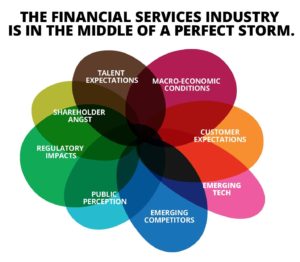Financial Services 2025: Eight Strategic Forces that are Transforming the Industry

What happens to today’s banks if interests rates remain at historical lows, global economic growth remains tepid, and new channels emerge that productively allocate capital better, faster and cheaper?
This is part two in a four-part series. Read Chapter 1 – How to Grow in the Challenging Years Ahead and Chapter 3 – 3 Core Principles to Unlock Growth
The Financial Services industry is in the middle of a perfect storm, caused by eight distinct yet interconnected strategic forces. This combination of internal and external forces are compelling executives to invest scarce resources in multiple, contradictory directions. This is widening the trust gap between the industry and its customers, as pressures to retain current margins leveraging existing models comes at the expense of transparency and customer alignment.
Executives are well aware of the compounding effect of these disparate but interdependent forces. They know that these forces demand a holistic response. However, all too often we witness a reversion to silos, which drives more internal focus, localized optimization, and jargon-filled communication. This in turn reinforces the trust gap.
We believe that the key to unlocking organic growth is to tackle the trust gap head on, and to place the customer at the center of all decisions – across front, middle and back offices. Executives must adopt and invest in a clear customer-led strategy. They must harness these strategic forces to create new value, instead of falling victim to them.
This article provides a brief overview of these eight strategic forces, and asks for your thoughts on each. We finish with the implications of these forces on the future of the investment management business. We will discuss our recommendations and the path forward in the final articles of this series.
Customer Expectations
Investors across wealth spectrum, across genders and across generations are increasingly choosing banks, advisors, and products that deliver on transparency, clarity and alignment. This trend will accelerate as market volatility and low interest rates put pressure on investor returns.
Regulatory Impacts
The growing patchwork of regulations already impose a steep complexity tax on financial services firms. Pending regulations such as the fiduciary standard rule, and the broader shift towards pan-national regulatory regimes will result in substantial shifts in the investment management landscape. Automation will enable deeper regulatory focus on removing all conflicts of interests.
Public Perception
The public still largely distrusts the investment management industry, and thinks the “game is rigged”. As a result, millennials will continue to fragment their financial relationships, leading to the loss of loyalty and stickiness. This will continue to have a self-reinforcing effect on changing customer expectations and heightened regulatory scrutiny.
Emerging Competitors
Robo-advisors are just canaries in the coal mine for what is to come. Large technology giants like Amazon and Google have made investments in the financial services ecosystem, testing the waters for possible new forays. Google is one of the largest investors in FinTech. Given their current public perception as more trustworthy customer advocates, they may quickly take AUM and lending share without facing the same regulatory scrutiny as banks.
Macroeconomic Conditions
The incredible volatility in the markets, perpetually low interest rates, falling consumption in China, and the lack of a clear global growth engine will add to instability that is making predictable, steady growth impossible. Compounding this effect is the impact of increasing wealth concentration from growing income inequality, and global climate change on both developed and developing economies. The growing fungibility of capital will make local markets vulnerable to global economic dynamics.
Talent Expectations
The best talent does not want to work for ‘slow, steady, bloated, and political.’ They want an environment where they can do their best work, and make a valuable impact. They seek mission-driven opportunities instead of “ladders to climb.” They will not patientially climb a traditional career ladder. Traditional investment management companies that retain their current operational and organizational structures will not attract the next generation of high potential job hunters.
Emerging Technologies
Beyond the widely heralded distributed ledgers and Internet of Things, new technology vectors are emerging that will fundamentally alter many of the core elements of the banking value chain. Quantum computing will eliminate encryption-based security, and allow for extreme automation of investment management. New big data based solutions will automate the efficient allocation of capital across multiple asset classes and make complete transparency and traceability as the new normal.
Shareholder Angst
Shareholders of these companies are well aware of these incredibly turbulent forces, and the lack of a clear vision to rethink the core industry value proposition. As valuation multiples industry-wide continue to shrink, and as margin erodes from new competitive pressures, shareholder angst will continue to accelerate. The stock price collapses affecting European banking giants today await portend the effect on the entire financial sector.
WHAT DO YOU THINK?
We crafted a set of customer-led hypotheses to help executives reimagine responses to these forces. These hypotheses are based on our experience working with multiple global financial services organizations across the globe and market research. We would like to hear your opinions about the validity of each of these hypotheses. Here are the hypotheses and the results of a recent poll from readers of this article.
Pricing opacity will end. Customer-led companies must deliver on transparency (in distribution) & trust through the entire value chain. While simple to consider, this may lead to substantial changes across multiple functional areas and redefine existing business models. For example, revenue sharing arrangements between asset managers and brokerage firms must end.


